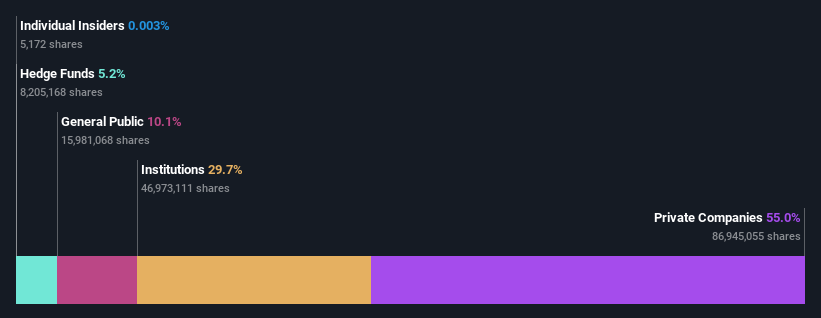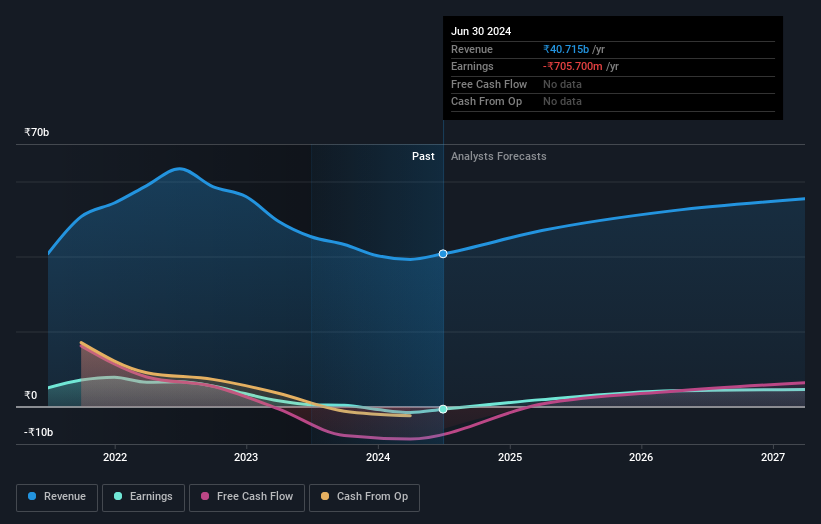Chemplast Sanmar Limited's (NSE:CHEMPLASTS) market cap dropped ₹5.1b last week; individual investors who hold 55% were hit as were institutions

Key Insights
- The considerable ownership by private companies in Chemplast Sanmar indicates that they collectively have a greater say in management and business strategy
- Sanmar Holdings Limited owns 55% of the company
- 30% of Chemplast Sanmar is held by Institutions
Every investor in Chemplast Sanmar Limited (NSE:CHEMPLASTS) should be aware of the most powerful shareholder groups. We can see that private companies own the lion's share in the company with 55% ownership. In other words, the group stands to gain the most (or lose the most) from their investment into the company.
While the holdings of private companies took a hit after last week’s 6.6% price drop, institutions with their 30% holdings also suffered.
Let's delve deeper into each type of owner of Chemplast Sanmar, beginning with the chart below.
See our latest analysis for Chemplast Sanmar

What Does The Institutional Ownership Tell Us About Chemplast Sanmar?
Institutions typically measure themselves against a benchmark when reporting to their own investors, so they often become more enthusiastic about a stock once it's included in a major index. We would expect most companies to have some institutions on the register, especially if they are growing.
Chemplast Sanmar already has institutions on the share registry. Indeed, they own a respectable stake in the company. This can indicate that the company has a certain degree of credibility in the investment community. However, it is best to be wary of relying on the supposed validation that comes with institutional investors. They too, get it wrong sometimes. If multiple institutions change their view on a stock at the same time, you could see the share price drop fast. It's therefore worth looking at Chemplast Sanmar's earnings history below. Of course, the future is what really matters.

Our data indicates that hedge funds own 5.2% of Chemplast Sanmar. That catches my attention because hedge funds sometimes try to influence management, or bring about changes that will create near term value for shareholders. Our data shows that Sanmar Holdings Limited is the largest shareholder with 55% of shares outstanding. This essentially means that they have extensive influence, if not outright control, over the future of the corporation. SBI Funds Management Limited is the second largest shareholder owning 9.8% of common stock, and Amansa Capital Pte. Ltd. holds about 5.2% of the company stock.
While studying institutional ownership for a company can add value to your research, it is also a good practice to research analyst recommendations to get a deeper understand of a stock's expected performance. Quite a few analysts cover the stock, so you could look into forecast growth quite easily.
Insider Ownership Of Chemplast Sanmar
While the precise definition of an insider can be subjective, almost everyone considers board members to be insiders. Management ultimately answers to the board. However, it is not uncommon for managers to be executive board members, especially if they are a founder or the CEO.
I generally consider insider ownership to be a good thing. However, on some occasions it makes it more difficult for other shareholders to hold the board accountable for decisions.
Our most recent data indicates that insiders own less than 1% of Chemplast Sanmar Limited. But they may have an indirect interest through a corporate structure that we haven't picked up on. It has a market capitalization of just ₹72b, and the board has only ₹2.4m worth of shares in their own names. We generally like to see a board more invested. However it might be worth checking if those insiders have been buying.
General Public Ownership
The general public, who are usually individual investors, hold a 10% stake in Chemplast Sanmar. While this group can't necessarily call the shots, it can certainly have a real influence on how the company is run.
Private Company Ownership
It seems that Private Companies own 55%, of the Chemplast Sanmar stock. It might be worth looking deeper into this. If related parties, such as insiders, have an interest in one of these private companies, that should be disclosed in the annual report. Private companies may also have a strategic interest in the company.
Next Steps:
It's always worth thinking about the different groups who own shares in a company. But to understand Chemplast Sanmar better, we need to consider many other factors. To that end, you should be aware of the 1 warning sign we've spotted with Chemplast Sanmar .
If you are like me, you may want to think about whether this company will grow or shrink. Luckily, you can check this free report showing analyst forecasts for its future.
NB: Figures in this article are calculated using data from the last twelve months, which refer to the 12-month period ending on the last date of the month the financial statement is dated. This may not be consistent with full year annual report figures.
New: AI Stock Screener & Alerts
Our new AI Stock Screener scans the market every day to uncover opportunities.
• Dividend Powerhouses (3%+ Yield)
• Undervalued Small Caps with Insider Buying
• High growth Tech and AI Companies
Or build your own from over 50 metrics.
Have feedback on this article? Concerned about the content? Get in touch with us directly. Alternatively, email editorial-team (at) simplywallst.com.
This article by Simply Wall St is general in nature. We provide commentary based on historical data and analyst forecasts only using an unbiased methodology and our articles are not intended to be financial advice. It does not constitute a recommendation to buy or sell any stock, and does not take account of your objectives, or your financial situation. We aim to bring you long-term focused analysis driven by fundamental data. Note that our analysis may not factor in the latest price-sensitive company announcements or qualitative material. Simply Wall St has no position in any stocks mentioned.
About NSEI:CHEMPLASTS
Chemplast Sanmar
Engages in manufacturing and selling of specialty chemicals in India.
Reasonable growth potential and fair value.


